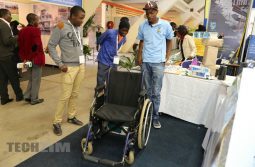There’s quite a lot happening in the tech spaces around Zimbabwe, yet with so little exposure or recognition. This is not only discouraging for the techies building things, but it leaves Zimbabweans unaware of the opportunities and potential that lie around them.
I will therefore be blogging about these innovative Zimbabweans that are building things that solve real problems they have observed or faced themselves.
This is the case for a head motion controlled wheelchair that an electronics student at NUST, Howard Mpofu, is building.
For a while Howard had to push his grandfather around after a stroke had paralysed his hands and feet. The major problem with this was not pushing him, but how his grandfather felt about being pushed to and from places. This made Howard realise how people with similar conditions whether by amputation or quadriplegia had to not only deal with the hassles that come with moving from point A to B, but also with the emotional stress of feeling ‘useless’ thereof – hence this innovation.
The system is an automatic head motion controlled wheelchair which uses an accelerometer and a digital system attached to a cap that is worn by the individual. The cap then wirelessly communicates with another digital system on the wheelchair such that an individual can move to any direction i.e. forward, left and right as well as stop using head movements. This wheel chair is of course the 1st of its kind to be designed in Zimbabwe and as such it captured the attention of Hon VP Mnangagwa during the ZITF.
The wheelchair has not yet been commercialised as it is still work in progress but the estimated price would be US$560 which is quite reasonable considering that electric wheelchairs are relatively expensive especially after factoring in importation expenses. However, not only will this innovation help with regular movement but it can also be further manipulated and used at Paralympic sporting activities to help players increase on speed and efficiency.




When technology is being led by passion, desire to resolve real life problem, then chances are high to gain traction.
Well done!!
This is nice
Well done professor. That’s the way to go
innovative indeed. I am greatly inspired